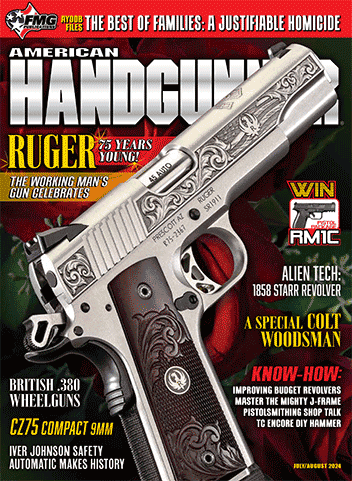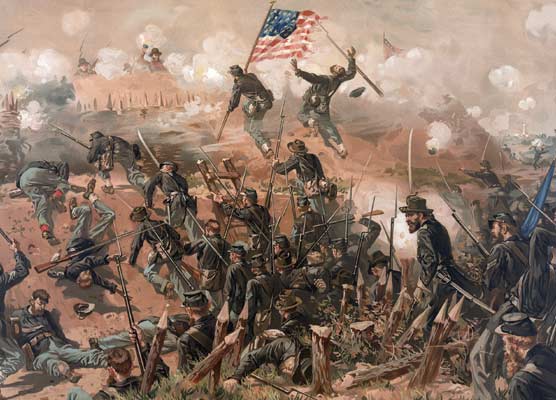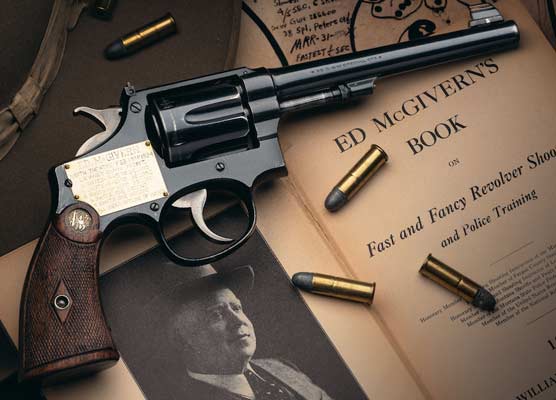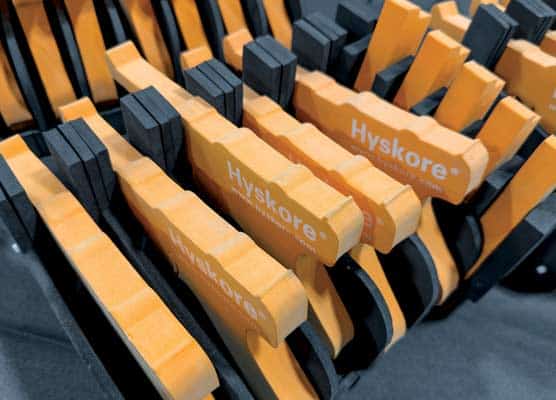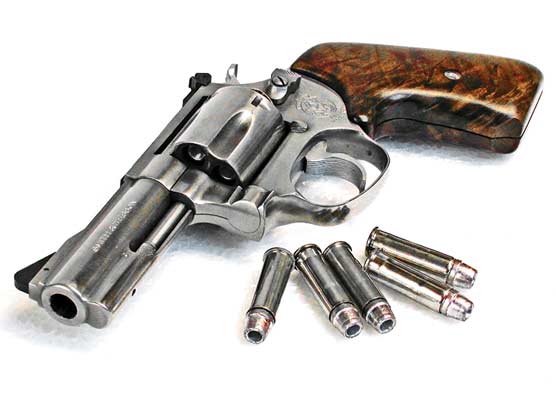The 7-1/2" SAA Colt New Frontier
For me, at least, the original Single Action Army is the most eye-pleasing of sixguns. However, in a more practical sense, it needs better sights than the standard hog wallow trough through the top of the frame and post front sight. With the taming of the frontier and the use of firearms more and more for recreation, Colt realized this and, in 1888, fitted the standard Colt Single Action sights to be more conducive to accurate shooting.
The standard model Colt Single Action Army was fitted with a flat-topped frame with a rear sight mounted in a dovetail and adjustable for windage. This was mated up with a front sight adjustable for elevation; both adjustments were relatively crude by today‘s standards. However, they were way above the standard sights then available on the Colt. This was a step forward, but the grip frame and hammer of the Single Action remained unchanged and were still better suited for speed from the holster and gunfighting than for target shooting.
In 1895, Colt made some major improvements by changing the grip frame, hammer, and trigger of the Flat-Top Target Model Single Action. The grip frame now came up higher behind the trigger guard and also on the backstrap so the sixgun would nestle deeper and more securely in the hand. The Single Action grip was designed to slide in the hand under recoil; the new Bisley Model Flat-Top Target was just the opposite — it did not move nearly as much when the gun recoiled. The hammer was changed dramatically; the spur was made wider, and it also rode lower, making it more easily reached for cocking. It was also mated with a trigger, which was not only wider, it was also more curved than the standard trigger. This new single-action sixgun received its name from the famous target range in England.
From 1873 through 1940, almost 357,000 Colt Single Actions were produced. Of these, just over 310,000 were standard model Single Actions while 917 were SAA Flat-Top Target Models. On the Bisley side of the ledger, 976 were in the original Flat-Top Target configuration, while more than 44,000 were standard models. The most popular chambering in both the Bisley and Bisley Target Models was the easy shooting .32-20; the second most popular was the .38-40, followed in order by the .45 Colt and .44-40. In the Standard Model Single Action, the .45 Colt was well ahead of the rest and followed in order by the .44-40, .38-40 and .32-20. The production of all Flat-Top Target Models ended before WWI.
The New Frontier
The Flat-Target Model sights were very crude. However, this was all changed in the Second Generation of the Target Model. In late 1961, Colt introduced the New Frontier model in honor of President John F. Kennedy‘s ringing declaration, “We stand at the edge of a New Frontier …” To further honor the new young president, Colt went to work on a special engraved presentation model New Frontier to present to JFK. However, the dark days of November 1963 occurred before the Colt was finished, and it was never presented.
To come up with the New Frontier, Colt basically took their standard Single Action Army, which was now in its 2nd Generation phase as production had resumed in 1955. Colt generously flat-topped the frame as Ruger had just accomplished with their brand new .357 Blackhawk, fitted it with a fully adjustable rear sight, matched up with a ramp-style front sight and the New Frontier was born. The finish on these Colts, which I consider the most beautiful single actions ever factory produced, consisted of a case-hardened frame as only Colt could do it, with the balance of the sixgun being Colt‘s Royal Blue as found on .357 Magnum Pythons of the same era.
The Colt Single Action Army may be the choice of traditionalists. However, the New Frontiers maintain the beautiful looks, feel and balance of the Colt Single Action Army with the added advantage of adjustable sights. The adjustable-sighted Colt New Frontier requires nothing more than a proper-fitting screwdriver to change the point of impact. The addition of adjustable sights also turns a Colt Single Action into a viable hunting handgun.
New Frontier Production
The first run of Colt New Frontiers, known as 2nd Generation sixguns, began at serial number 3000NF and finished in 1974 at serial number 72XX. Four chamberings were offered in this first run of magnificent “modern” Colt Flat-Top Target sixguns: .45 Colt, .44 Special, .357 Magnum, and very rarely, .38 Special. Standard barrel lengths of 4¾”, 5½” and 7½” were cataloged but not in every caliber. By 1967, the .44 Special had been dropped from the New Frontier production with only 135 of the 7½” barrel lengths being produced. Serial numbers for the 2nd Generation New Frontier run from 3000NF to 73XXNF. In 1978, the New Frontier went back into production, joining the 3rd Generation run of Single Action Armies. Serial numbers began at 01001NF, using five digits instead of four. Chamberings were .45 Colt, .357 Magnum, .44 Special and .44-40. Production ended in 1982; however, a few were assembled from parts for the next two years.
Loading And Shooting
The Colt New Frontier .44 Special is an excellent hunting handgun with proper loads. I have used the Heavy .44 Special Keith load in both 2nd and 3rd Generation New Frontiers with no problem whatsoever with bullets sized at .0428″ and .0431″, respectively. But do not take this load for granted! Care should be used with heavy loads in the .44 Special New Frontier. My use of today’s #2400 by Alliant with the 250-grain hard cast Keith bullet has been cut back to 15.5 grains. For most of my everyday use in the .44 Special with either generation and either the Single Action Army or the New Frontier, I stay with the Keith bullet over 7.5 grains of Unique for around 900 fps. This load doesn’t strain me or the sixguns.
As a bullet caster, I have a great advantage, namely being able to custom tailor bullet diameters to fit each particular sixgun. There is a lot of variation found in the chamber throats of both .45 Colt and .44 Special sixguns. Applying a pin gauge to the .45 New Frontier gave me a uniform reading of 0.455″ for all six chambers. I keep a generous supply of reloads on hand with both 0.452″ and 0.454″ diameter bullets, so for the most part, I chose the latter. However, I was pleasantly surprised to find the smaller bullets also shot well, as did factory-loaded ammunition.
A New Generation
The New Frontier had been gone for 30 years. At a meeting with Colt Officials in the early 1990s, we were told we would never see the New Frontier again. Never say never, especially when it comes to .44 Specials. The year 2011 marked the 175th Anniversary of Colt Single Actions, going all the way back to the first one, the percussion Paterson of 1836. It was fitting for Colt to resurrect the New Frontier to help celebrate this anniversary and all New Frontiers produced during the year have a special Anniversary Marking on the barrel consisting of “1836 — 175th Anniversary — 2011” and serial numbers began at 20000NF.
Colt at least announced all three standard barrel lengths — 4¾”, 5½” and 7½” — were to be produced in three chamberings of .357 Magnum, .44 Special and .45 Colt. The first two production runs consisted of the .45 Colt with a 7½” barrel and the 5½” .44 Special. Shortly thereafter, I was informed I would soon have a 4¾” version. However, this proved to be long on promise and extremely short on actuality. I wish now I had also ordered a .44 Special New Frontier with a 7½” barrel.
I did receive and subsequently purchase a 7½” .45 Colt New Frontier. I have a long acquaintance with New Frontiers, both 2nd and 3rd Generation versions, including all three barrel lengths and chamberings of .45 Colt, .44 Special, .357 Magnum and .44-40. As nice as they are, they actually pale in comparison to this “New” New Frontier.
This new production New Frontier is the most beautifully finished Colt Single Action I have ever experienced. Not only is the finish — consisting of a case-hardened frame and the balance of a blue you can see your ancestors in — absolutely stunning, it is also exceptionally well-fitted with no sharp edges. Grip frame to mainframe fit is as it should be, and running a finger over the seams shows a nice smooth transition. The lockup is tight; trigger pull, while not perfect, is certainly more than adequate. Grip panels are nicely fitted to the grip frame, and although a very plain wood, are shaped to fit my hand perfectly. I’ll take proper fitting and shape over fanciness anytime; however, as with most of my Colts, it has now been fitted with custom stocks.
Where are we today with the Colt New Frontier? That is anybody’s guess as both the Single Action and New Frontier have been in and out of production over time. We can only hope we will someday see them again. Meanwhile, I will continue to shoot and enjoy my 2nd and 3rd Generation New Frontiers, especially those with 7½” barrels, chambered in .45 Colt, .44 Special, .44-40 and .357 Magnum.









